Some Quick Ice, But Not Fast Ice

I was driving back from Sturg after a haircut appointment. My new barber, Desirée at Razor’s Edge, had done a pretty decent job, considering what she had to work with. On the way back to Baileys Harbor, I decided to drive up North Shore Drive past the old stone quarry and the Pinney Park boat launch. I had heard that anglers were catching fish just off the park. Apparently, there was good ice there, a rare commodity this winter. As I rounded the corner just before the park, I was met with an ominous sight. Hoovering about a hundred feet above the ice was a large orange and white Sikorsky helicopter. Dangling below the chopper was a figure, spinning in the wind attached to a gossamer-like line. The United States Coast Guard was performing an ice rescue. Fearing for the safety of one of my fellow ice anglers, I veered into the parking lot. The launch area was filled scattered ER personnel and emergency vehicles of various types. A Door County Incident Command mobile unit was set up just off the boat launch. I got out of my truck and walked toward the action. Fascinated, I watched as the person on the wire was gingerly deposited INTO the icy waters and was left bobbing among the ice flows. Several moments later, another figure appeared from the chopper. This one had large fins attached to each leg and was apparently a USCG rescue diver. At this point I began to notice a lack of any real urgency in the people around me. There were emergency rescue personnel all along the ice edge, but they seemed to be engaged in activities unrelated to the actions of the helicopter or the rescue diver. With some relief, I realized that this was not an actual rescue, but a practice session for the Coast Guard and local emergency responders to prepare for potential ice rescues. No one was in danger. In addition to the actions on the chopper, ER teams were extracting “victims” from the ice edge who, in this simulation, had fallen through the ice. Back out on the bay, the rescue diver had been successfully deposited in the icy water and was making their way to the faux victim. In short order, the rescue diver had secured the victim, and both were raised into the helicopter. The chopper then left the area, completing a successful, albeit mock, rescue.
Ice safety is always a critical issue for ice anglers, particularly the last couple of years with the deteriorating and unpredictable ice conditions. Just this week, it was reported that there were three different ice rescues that involved at least nine people stranded on the ice off Bay Shore County Park. With the late development of ice on the Bay this year and the prospect of continuing warm conditions, I was doubtful that I would be getting out to target whitefish at all this season. I love to fish, but I’m not an idiot. Most anglers, evidence to the contrary aside, share my belief that a fish is not worth risking your life for. Well, maybe for a really big fish, but surely not for a meal of whitefish. Hopeful, I continued to monitor the nearshore ice. I began to see a few intrepid anglers tentatively making their way out onto the frozen edges of pancaked ice along the bay shore. Tents and shacks started to pop up near Egg Harbor and off the quarry in Sturgeon Bay. This vanguard of ice anglers gave me confidence that I could venture onto the ice without fear being the subject of the next “Angler Falls Through Ice” headline. I loaded my gear into the truck and headed out, determined to put some whities on the ice.
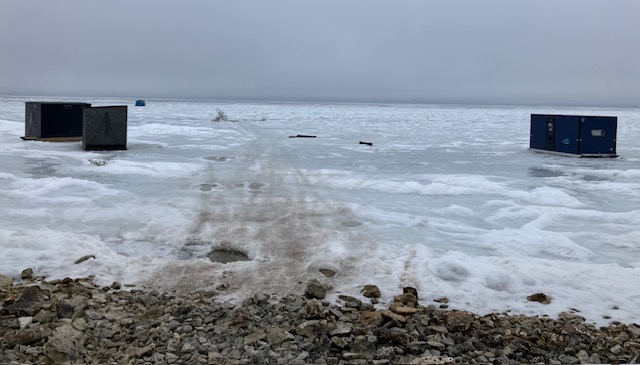
I dragged my Eskimo shelter onto an ice surface that was ragged and broken. Blocks of early ice had been wedged by the wind into a jigsaw-like pattern, coalesced into a solid mass. A few narrow open cracks had developed near the shore, a response to the shifting ice. I easily stepped over these. Following the well beaten path of previous anglers, I made it out about a hundred yards onto the ice. With the aid of a Navionics navigation app on my iPhone, I moved to a location where I had gotten whitefish previous seasons. I retrieved the ice drill from the sled. I use a K-Drill attached to a Lithium battery powered DeWalt hammer drill. I quickly bored a hole and discovered, to my relief, eight inches of good clear ice. I deployed my Vexilar sonar unit to find I was over 35 feet of water. I also detected the tell-tale echoes of fish moving along the bottom. Could be whitefish. Ice fishing sure has evolved since the early days of trudging out on the ice with nothing more than a plastic bucket, an iron spud and a wooden ice rod wound with 20 yards of monofilament. Today I cannot imagine dropping a line through a jagged hole in the ice armed with nothing but hope. For better or worse, as with much modern technology, whatever becomes possible eventually becomes necessary.
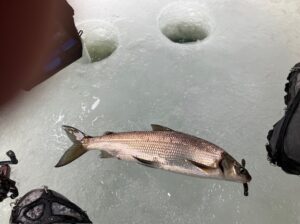
Setting up my shelter, I plunked into my chair and got to work. The rig I was using was a Goby-colored plastic tail on a black-headed jig. Nine inches above the jig was a “slider” hook. This small bare hook can move up and down in the water column. Festooned with a juicy wax worm it presents an enticing morsel of food to any fish below. Passing the array through the hole, I watched on my sonar as the offering approached the bottom. I slowly lifted then dropped the jig several times attempting to emulate a nervous Round Goby, the preferred food of whitefish these days. Soon ghost like echoes appeared on the Vexilar near the jig. The echoes mirrored the movements of the jig and then, without warning, my rod bent sharply and I felt the weight of the first whitie of the season. Sensing the pulsations of a battling whitefish through a thin strand of line is exhilarating. This is what I had come out here for. This was the thrill. Then, just as suddenly, the thrill was gone. The line had gone slack. The fish was off. The lurid string of colorful words that spewed from my mouth, thankfully, was heard only by myself and a few seagulls. I quickly lowered the jig back to the lake bottom. It took a while, but eventually fish returned. Groups of fish would wander in, scrutinize my bait, but then would wander off rejecting my offering. Finally, one fish committed, and I had another chance. After a spirted fight, I slid the first whitefish of the season on to the ice. I ended the day catching four whitefish, lost several others and had numerous hits. I took three nice fish home for supper.
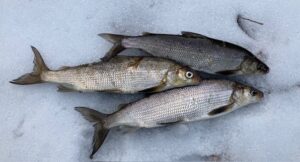
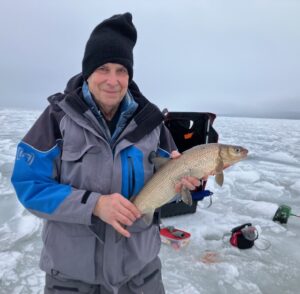
I notified my fishing buddies of the safe ice and active fish, so the next day was joined by Paul and Jeff for another nice afternoon on the ice. All caught fish, but I had considerable bad luck, losing two fish on break offs. I still took home enough fish to share with some neighbors. The very next day, I joined Jeff and another local, Dave for a morning’s outing. Three days in a row on the ice was an unexpected treat considering we were not sure we would get on the Bay at all this year. I decided to try my luck in some shallower areas I have caught fish in the past. I set up in 15FOW, over a mussel strewn gravely bottom. The cool thing about fishing shallow in this crystal water is that the bottom can be seen clearly. You can observe the fish approach your bait. At one point I watched a cautious whitefish slowly nose my jig then swiftly pounce on it. I lifted my rod and felt the weight of the fish. Although we did not fill the bucket or “get our limit” we did harvest enough fish for several nice meals. As many fish were also released. Another great day on the ice.
Alas, ice fishing on the bay may be coming to a premature end. Temperatures in the 40s, rain and gusty winds have destroyed much of the little safe ice remaining. Barring a dramatic cold snap, I may be soon packing away the ice drill and preparing the Maggie Leigh for open water. Be assured I won’t push the season. I don’t want to become a target for one of those USCG rescue divers.
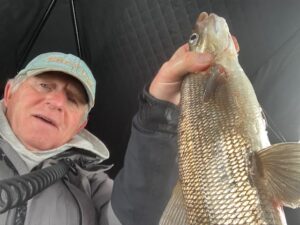
I finished watching the emergency responders perform their preparedness drills, then hopped back in my truck and headed home. As I drove north through Little Harbor, just a few hundred yards north of the location where the Coast Guard was executing the ice-water rescue, I was struck by the sight of a lone angler out on the ice. I was not sure if they were aware of the nature of the activity so very nearby. I just hope that I never have need of the Coast Guard to perform an ice rescue on me, but I am grateful that they practice. A lot.
So long and thanks for all the fish, Bruce
Questions or comments to bsmith733@gmail.com

Great winter story to get the blood pumping about how fortunate we are in Wis for Emergency Services available, and for the natural resources we have under our feet (frozen) to keep us entertained. Love reading these stories.
Thanks Steve. Yes indeed and we got out a bit early this year. Thanks for the feedback. HA
Another good story, I mean factual recounts:) June is only 4 months away, let’s have another BS open?!
Thank Greg. June seemed to have come in March, for a while. B
Great post, you have pointed out some fantastic details, I also believe this is a very good website.
Thanks Louise. I appreciate the feedback. HA